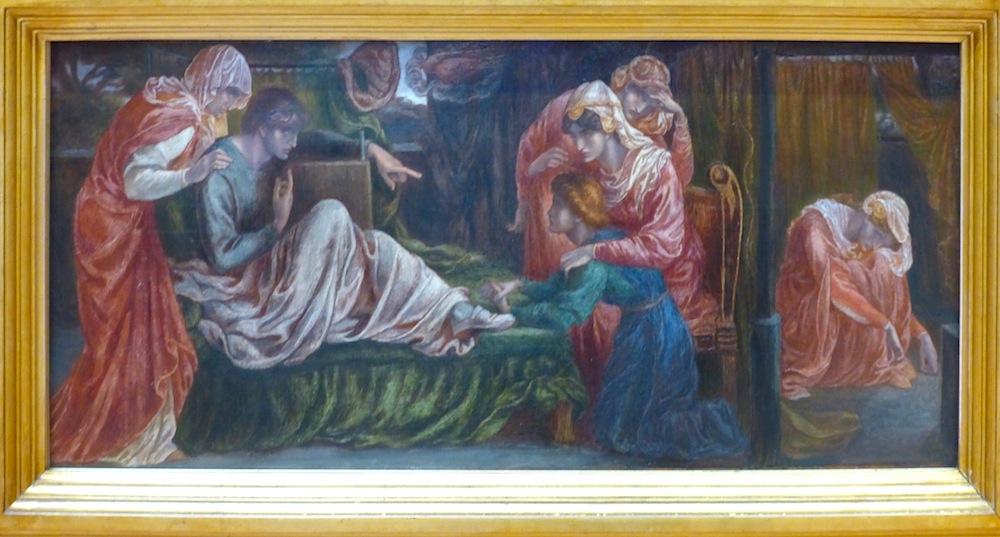
Dante Gabriel Rossetti's Dante's Dream on the Day of the Death of Beatrice. Replica with two predella panels. 1880. Oil on canvas. 178 x 133 cm. Bequeathed by Miss Ethel M Colman through The Art Fund, 1949. The Victoria Gallery at the McManus: Dundee's Art Gallery and Museum, Scotland. Museum Number: 6-1949. Rossetti's first painting on this subject was a watercolour of 1856. He later produced a large (210.6 x 317 cm) oil-painting with lifesize figures for his patron William Graham in 1878-80. Julia Straub points out the differences between this oil painting and the original watercolour: "They mirror a different aesthetic approach, the latter version providing a richer decorative background, offering a glimpse of Florence and a much more sensual rendering of details and colouring" (143, n.21). The McManus version is a smaller-scale copy of the oil-painting. It was also painted for Graham (see Straub 70), with the unique addition of the two predellas, and some accompanying text. [Click on this and the following images to enlarge them.]
Described on the museum's own site as "the most important of Rossetti's paintings in Scotland," the main frame shows Dante arriving at the bedside of the dead Beatrice, where the figure of Love, in a brilliant robe, is bestowing on her the kiss that Dante himself had never given her while she was alive. The colour of Love's robe is echoed in the poppies strewn on the floor, representing the sleep of death, while, according to Lionel Lambourne, the green of the attendant women's gowns suggests hope, the blossoms held by Love and strewn above Beatrice suggest purity, and the red doves on either side indicate the presence of love (441).

The text under this lower righthand predella panel reads: "Dante being sick and crying out in a dream of his lady's death, is mourned over by his near kinswoman whom other ladies lead thence by reason of her grief, and awaken him."
The text dividing the two predellas gives the title of the painting and a passage from the Vita Nouva:
Then Love said: "Now shall all things be made clear:
Come and behold our lady where she lies."
These 'wildering fantasies
Then carried me to see my lady dead.
Even as I there was led,
Her ladies with a veil were covering her
And with her was such very humbleness
That she appeared to say, I am at peace.

The text under the lower lefthand predella panel reads, "Dante recalling the incidents of his successful dream, recounts them to the ladies who have awakened him, whereto his grieving kinswoman also hearkens apart."
In discussing the large oil-painting, Straub notes in particular the change in style from Rossetti's "medievalist, Art-Catholic tendencies towards the more sensual, 'fleshly' aspect of his artworks in the more opulent manner of the old Venetian artists from the 1860s onwards. Beatrice, for whom Jane Morris sat model, is turned into a very beautiful, radiant corpse, who invites Love's kiss more than the Beatrice in the earlier painting, whose hands folded in prayer create a visibly distancing effect" (144, n.21). As for the predellas added to this smaller version, these seem to represent Rossetti's further and deeper thoughts on his subject, developed over the intervening years. "The two predellas take both the viewer and Dante back to an earthly realm, showing the birth of new poetry through the medium of the dreaming, visionary poet" (Straub 71). In other words, they show the effect of the dream on Dante, the inspiration (and suffering) that produced his great poetry.
Photographs (by kind permission of the McManus) and text by Jacqueline Banerjee. You may use these images without prior permission for any scholarly or educational purpose as long as you (1) credit the McManus: Dundee's Art Gallery and Museum, and the photographer, and (2) link your document to this URL in a web document or cite the Victorian Web in a print one.
Related Material
Bibliography
"Dante's Dream by Dante Gabriel Rossetti." Art Fund. Web. 1 November 2016.
Dante's Dream on the Day of the Death of Beatrice. The McManus. Web. 1 November 2016.
Lambourne, Lionel. Victorian Painting. London and New York: Phaidon, 1999.
Straub, Julia. A Victorian Muse: The After-Life of Dante's Beatrice in Nineteenth-Century Literature. London and New York: Continuum International, 2009.
Last modified 27 June 2020